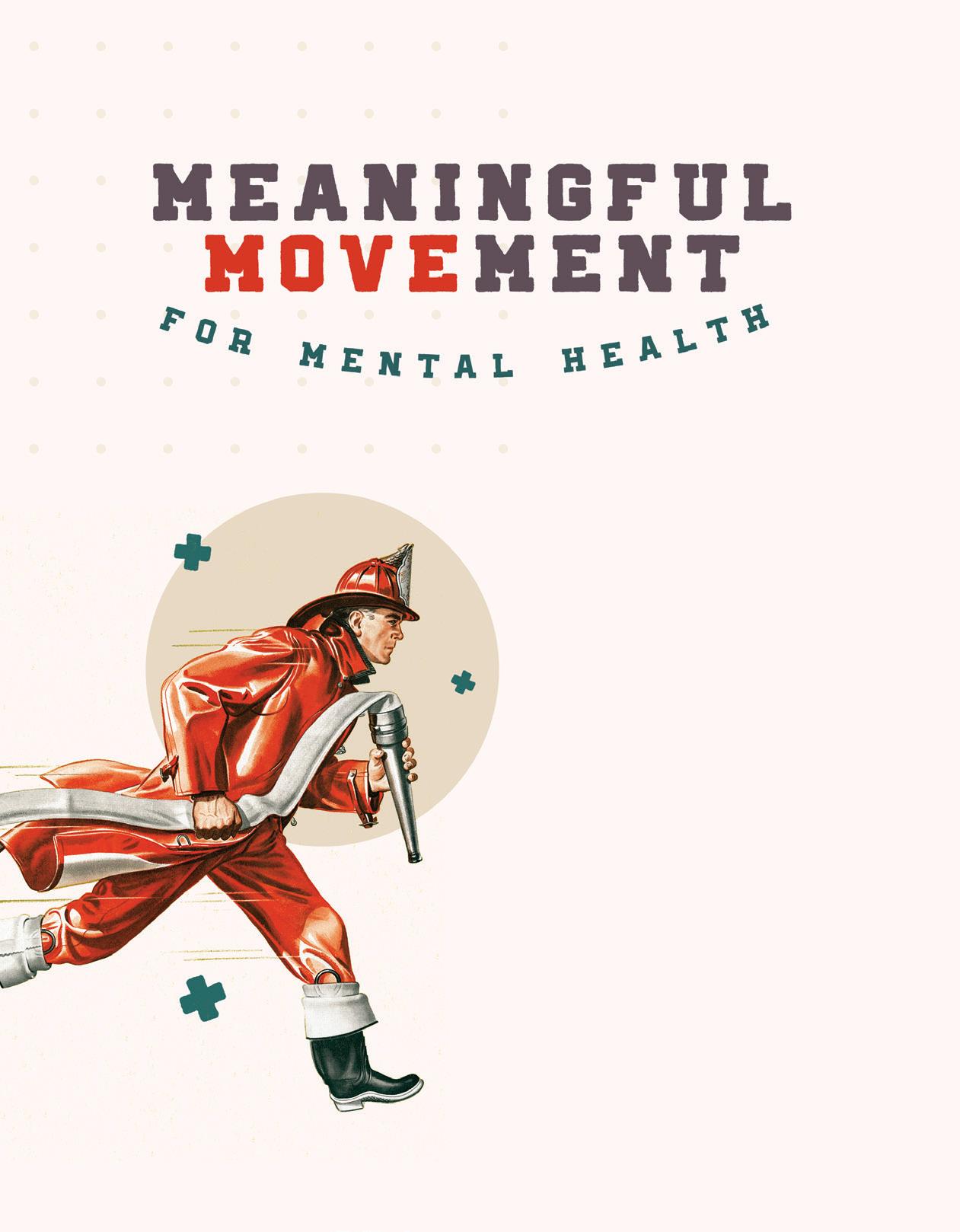
4 minute read
MEANINGFUL MOVEMENT FOR MENTAL HEALTH
By Annette Zapp, NSCA CSCS TSAC-F, FireSQfitness
Moving your body has a great impact on physical health. Health benefits of meaningful physical activity are well documented and correlated with many noncommunicable illnesses including cardiovascular diseases and cancers. Physical activity is also critical for building and maintaining muscle and bone mass, controlling blood glucose, and optimizing many other biomarkers.
But there’s more. Did you know that inadequate
physical exercise has also been demonstrated to have
a negative impact on mental health? Hippocrates knew this when, over 1600 years ago, he suggested going for a walk when you are in a rotten mood.
Both aerobic and anaerobic training are recognized means of decreasing both state and trait anxiety. (State anxiety is a temporary adverse reaction to an event, such as when a student is preparing for an important exam; while trait anxiety is a personality feature that is more consistent, for example an athlete who always gets an upset stomach prior to competition.) According to textbook published in 2020, there is a very strong correlation between depression and activity. In this case, less truly is
more. Less physical activity tends to correlate with more depression.
The great news, however, is that we have the power to partially modulate our outcomes with physical activity. Although we could get deep in the weeds in terms of intensity, mode, length of sessions, frequency of training and many other variables, let’s keep this simple: meaningful daily movement
of your body is beneficial, so let’s figure out some strategies to get that done!
Designing the perfect program to execute can be overwhelming, and the reality is that a perfect program doesn’t exist and a little good old consistent work ethic is just what the proverbial doctor ordered. In addition, even the experts who research exercise and mental health aren’t yet completely in agreement about what is best practice, so just get started and finesse things as you go along.
According to Jordan Syatt of Syatt Fitness, the majority of people don’t love working out, so he suggests embracing the fact that it’s not something you “want” to do, but empowering yourself with “choosing” to do the activity that you hate the least. Choose to move meaningfully on your own terms rather than waiting for a physician to drop the hammer and create an environment of threats. We’ll get to the nitty gritty of types of exercise momentarily, but let’s talk about what constitutes exercise when we’re looking at mental health gains.
As little as a 15 minute daily nature walk has been demonstrated to
decrease state anxiety (although the results for modulating depression are inconclusive). If you’re absolutely paralyzed with inability to decide on an exercise program, just start there: a 15-minute daily nature walk.
For ease of discussion, let’s break down exercise into three main categories: resistance training, cardiovascular training, and mindfulness-based practices.
RESISTANCE TRAINING
Resistance training is commonly equated with lifting weights including dumbbells and barbells, but it can easily be accomplished with body weight
exercises, rubber bands, kettlebells, sandbags and even sleds.
In addition to supporting mental health, resistance training can bolster strength, power or muscular endurance and may increase the volume of muscle mass in the body thereby improving body composition (as well as aesthetics) depending upon the exercise prescription.

Resistance training is especially important for older people to assist with maintaining muscle and bone mass.
Important to note: skeletal muscle serves as an insulin-driven “glucose disposal” tissue, thereby assisting with mediating circulating blood glucose.
Unsure of where to start? A simple bodyweight circuit will get you rolling. Include exercises for the upper and lower body as well as for the pillar or “core.” For a solid strategy, try alternating upper and lower body exercises and completing sets of AMAYCEP (As Many As You Can Execute Perfectly. Yeah. I totally made that acronym up). Still hesitant to try resistance training on your own? Contact a certified, experienced fitness professional to guide you. Pros certified by The National Strength and Conditioning Association (NSCA) and the American College of Sports Medicine (ACSM) are typically very knowledgeable.
CARDIOVASCULAR TRAINING
Cardiovascular training is exercise that serves to elevate the heart rate
above baseline and keep it up for a predetermined amount of time.
Generally, the training is either steady state (one intensity) or interval (varying intensities from greater to lesser). Both types have benefits, and adjusting the mode and intensity of training for greatest mental and physical health for the individual is the best plan.
Common methods of cardiovascular training include walking, running, swimming, biking, as well as resistance training to momentary muscle failure (completing resistance training in a circuit style for example). Again, Hippocrates had it correct and just simply walking every day will set you on a trajectory for improved health and wellness.
MINDFULNESS-BASED PRACTICES
Yoga, Pilates, meditation, and even a mindfulness-based breathing break can quickly right the ship when you’re stuck
in fight-or-flight and you need to be in rest-and-digest (or I prefer “feed-andbreed” but we digress…)
Beginner classes are a good way to sample these practices and there are some outstanding apps available for use at home including Calm, Insight Timer and Headspace.
To dip your toe in the waters of mindfulness-based training for absolutely free, the next time you find yourself amped up and upset, pause, reflect, and execute five four-count box breaths. Inhale for four counts, hold for
four, exhale for four and hold for four.
Wash, rinse and repeat. Your outlook will likely turn right around.
In summary, physical activity is important for physical and mental health so get out there and get some!
If you are in a bad mood go for a walk. If you are still in a bad mood go for another walk.
HIPPOCRATES (THE FATHER OF MEDICINE)










